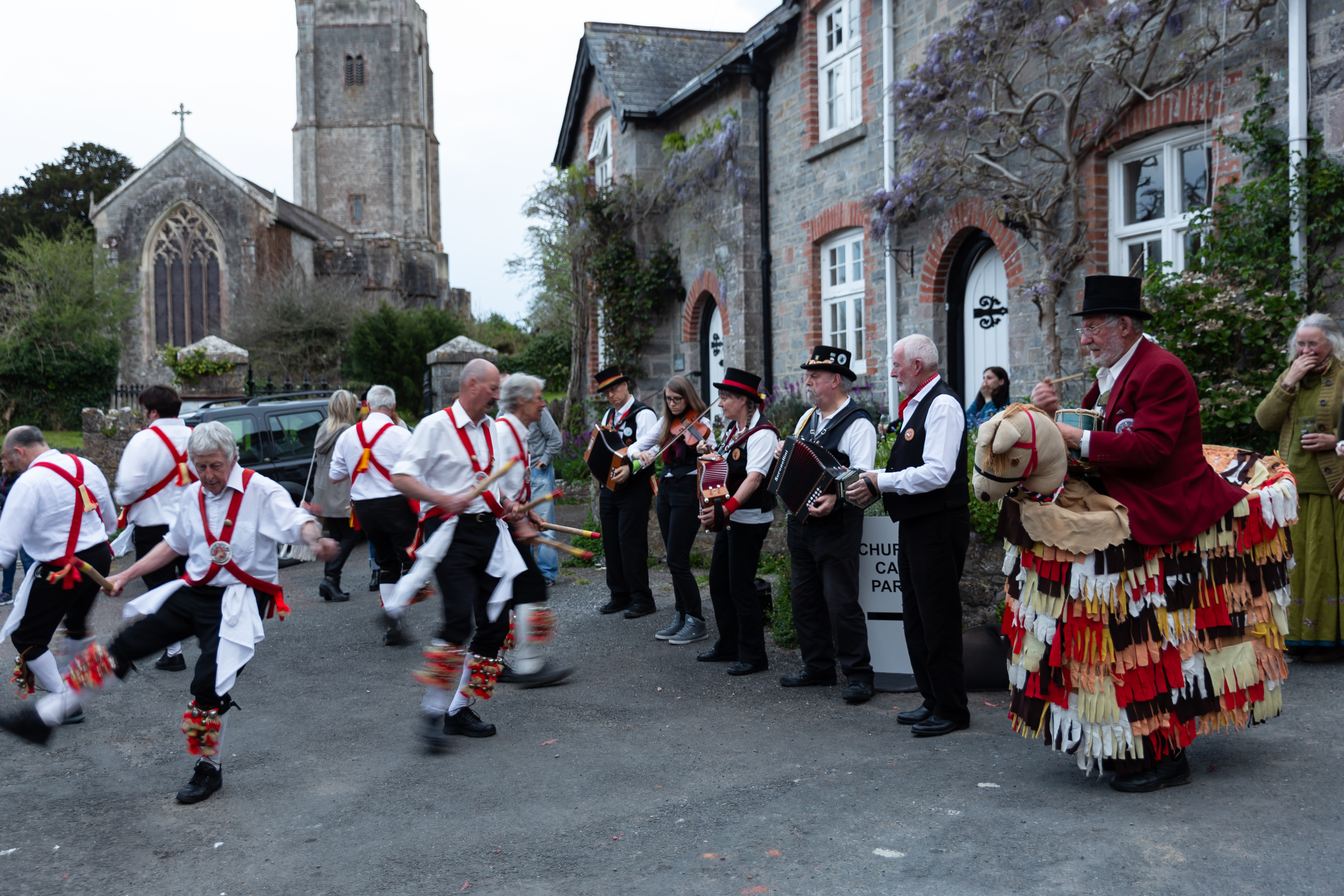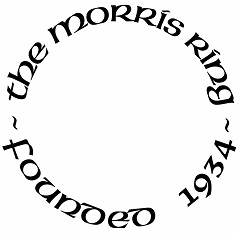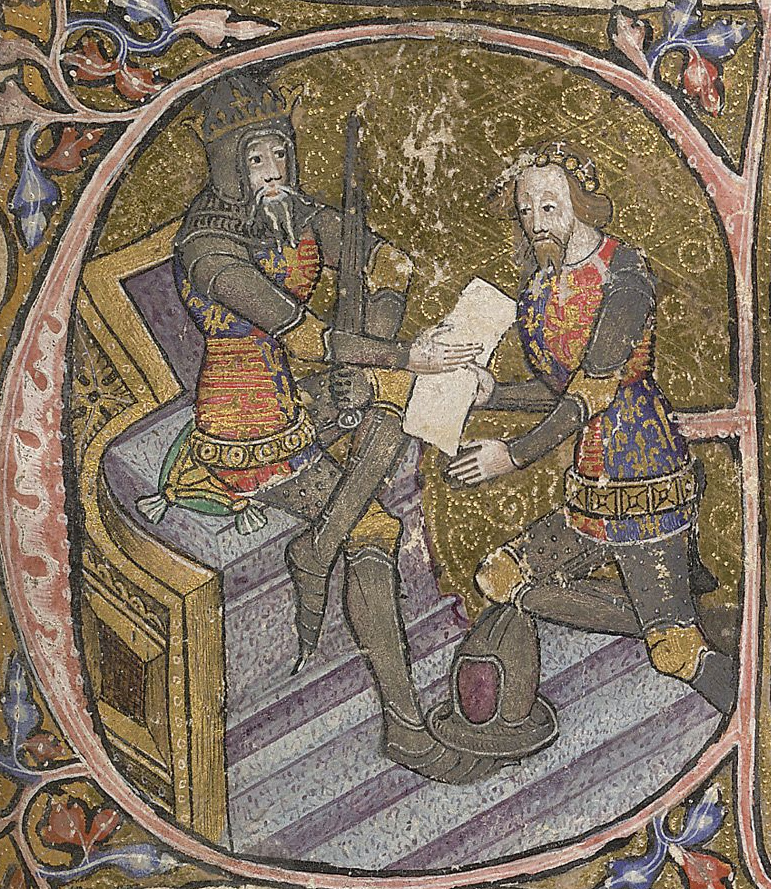|
Dartington Morris Men
Dartington Morris are a dance troupe based in Dartington, near Totnes, Devon, England. The group formed as a men's dance side (with male and female musicians) in 1968 at Dartington Hall and is a member side of the Morris Ring. In the early days the side practised in the 13th Century "Pillar Studio" at Dartington Hall. Whilst practising and contemplating a name for the side, Leonard Elmhirst, a founder of the Dartington Hall Trust, informed the men that he had once danced the Morris. He suggested that the side call themselves The Dartington Morris Men and use on their kit the Dartington crest of a white hart on a red rose, the crest of Richard II and his half-brother John Holland, 1st Duke of Exeter and 1st Earl of Huntingdon (who was given the manor of Dartington for services rendered in battle.) Two previous Dartington Morris sides are believed to have danced in the Totnes area; one at the end of the 19th century, the other in the 1930s. One of these sides apparently danced ... [...More Info...] [...Related Items...] OR: [Wikipedia] [Google] [Baidu] |
Dartington
Dartington is a village in Devon, England. Its population is 876. The electoral ward of ''Dartington'' includes the surrounding area and had a population of 1,753 at the 2011 census. It is located to the west of the River Dart, south of Dartington Hall and approximately two miles (3 km) north-west of Totnes. Dartington is home to an obsolete cider press (now the centrepiece of a shopping centre named after it), the Cott Inn, a public house dating from 1320, and Dartington Hall. In 1952, Dartington provided the venue for a major conference in the British studio pottery movement, organized by Muriel Rose, a leading arbiter of British crafts and design. The Dartington Conference drew major ceramic artists of the twentieth century including Bernard Leach and Michael Cardew, and, from Japan, Shoji Hamada and Soetsu Yanagi, whose participation signaled the restoration of post-World War II British-Japanese relations. Education * Dartington International Summer Schoo ... [...More Info...] [...Related Items...] OR: [Wikipedia] [Google] [Baidu] |
Totnes
Totnes ( or ) is a market town and civil parish at the head of the estuary of the River Dart in Devon, England, within the South Devon Area of Outstanding Natural Beauty. It is about west of Paignton, about west-southwest of Torquay and about east-northeast of Plymouth. It is the administrative centre of the South Hams District Council. Totnes has a long recorded history, dating back to 907, when its first castle was built. By the twelfth century it was already an important market town, and its former wealth and importance may be seen from the number of merchants' houses built in the sixteenth and seventeenth centuries. Today, the town has a sizeable alternative and New Age community, known as a place where one can live a Bohemianism, bohemian lifestyle, though has in recent times also gained a reputation as being a hotspot for Conspiracy theory, conspiracy theorists within the UK. The 2021 United Kingdom census, 2021 census recorded a population of 9,214, a 14% increase ... [...More Info...] [...Related Items...] OR: [Wikipedia] [Google] [Baidu] |
Devon
Devon ( ; historically also known as Devonshire , ) is a ceremonial county in South West England. It is bordered by the Bristol Channel to the north, Somerset and Dorset to the east, the English Channel to the south, and Cornwall to the west. The city of Plymouth is the largest settlement, and the city of Exeter is the county town. The county has an area of and a population of 1,194,166. The largest settlements after Plymouth (264,695) are the city of Exeter (130,709) and the Seaside resort, seaside resorts of Torquay and Paignton, which have a combined population of 115,410. They all are located along the south coast, which is the most populous part of the county; Barnstaple (31,275) and Tiverton, Devon, Tiverton (22,291) are the largest towns in the north and centre respectively. For local government purposes Devon comprises a non-metropolitan county, with eight districts, and the Unitary authorities of England, unitary authority areas of Plymouth City Council, Plymouth an ... [...More Info...] [...Related Items...] OR: [Wikipedia] [Google] [Baidu] |
England
England is a Countries of the United Kingdom, country that is part of the United Kingdom. It is located on the island of Great Britain, of which it covers about 62%, and List of islands of England, more than 100 smaller adjacent islands. It shares Anglo-Scottish border, a land border with Scotland to the north and England–Wales border, another land border with Wales to the west, and is otherwise surrounded by the North Sea to the east, the English Channel to the south, the Celtic Sea to the south-west, and the Irish Sea to the west. Continental Europe lies to the south-east, and Ireland to the west. At the 2021 United Kingdom census, 2021 census, the population was 56,490,048. London is both List of urban areas in the United Kingdom, the largest city and the Capital city, capital. The area now called England was first inhabited by modern humans during the Upper Paleolithic. It takes its name from the Angles (tribe), Angles, a Germanic peoples, Germanic tribe who settled du ... [...More Info...] [...Related Items...] OR: [Wikipedia] [Google] [Baidu] |
Dartington Hall
Dartington Hall in Dartington, near Totnes, Devon, England, is an historic house and country estate of dating from medieval times. The group of late 14th century buildings are Grade I listed; described in Pevsner's Buildings of England as "one of the most spectacular surviving domestic buildings of late Medieval England", along with Haddon Hall and Wingfield Manor. The medieval buildings are grouped around a huge courtyard; the largest built for a private residence before the 16th Century, and the Great Hall itself is the finest of its date in England. The west range of the courtyard is regarded nationally as one of the most notable examples of a range of medieval lodgings. The medieval buildings were restored from 1926 to 1938.Buildings of England - Devon. Authors - Nikolaus Pevsner and Bridget Cherry. Published 1989 The site is the headquarters of the Dartington Trust, which currently runs a number of charitable educational programmes, including Schumacher College, Dart ... [...More Info...] [...Related Items...] OR: [Wikipedia] [Google] [Baidu] |
Morris Ring
The Morris Ring is one of three umbrella groups for Morris dance sides. It was founded in 1934 by 6 sides: Greensleeves, Cambridge, East Surrey, Letchworth, Oxford and Thaxted. Members may meet several times a year, each Ring Meeting being hosted by a different member side (or several working together). The Morris Ring has grown to about 150 sides today, with another 35 associate and joint member sides, including teams from Australia, Canada, Denmark, the Netherlands and the U.S.A. Originally an association of men's Morris teams, at the 2018 Annual Representatives Meeting there was overwhelming support for a proposal to enable any morris team, whatever its gender make up, to become a member of The Morris Ring if they support the founding principles of the organisation: ''"The object of the Morris Ring shall be to encourage the performance of the Morris, to maintain its traditions and to preserve its history; to bring into contact all the Morris Clubs or Teams. The purpose of the ... [...More Info...] [...Related Items...] OR: [Wikipedia] [Google] [Baidu] |
Leonard Elmhirst
Leonard Knight Elmhirst (6 June 1893 – 16 April 1974) was a British philanthropist and agronomist who worked extensively in India. He co-founded with his wife, Dorothy, the Dartington Hall project in progressive education and rural reconstruction. Biography Leonard Elmhirst was born into a landed gentry family in Worsbrough (now part of Barnsley, Yorkshire), where the family seat is Houndhill. He was the second of nine siblings (eight boys and one girl). His elder brother, Captain William Elmhirst, was killed on 13 November 1916, aged 24, while serving with the 8th Battalion East Yorkshire Regiment during the Battle of the Somme, and the third son, Second Lieutenant Ernest Christopher Elmhirst, was killed on 7 August 1915, aged 20, while serving with the 8th Bn. Duke of Wellington's (West Riding Regiment) during the Gallipoli Campaign; both during World War I. The fourth son, Thomas became Air Marshal Sir Thomas Elmhirst (KBE, CB, AFC, DL, RAF). In 1912 Leonard Elmhirst went ... [...More Info...] [...Related Items...] OR: [Wikipedia] [Google] [Baidu] |
White Hart
The White Hart (" hart" being an archaic word for a mature stag) was the personal badge of Richard II, who probably derived it from the arms of his mother, Joan "The Fair Maid of Kent", heiress of Edmund of Woodstock. It may also have been a pun on his name, as in "Rich-hart". In the Wilton Diptych (National Gallery, London), which is the earliest authentic contemporary portrait of an English king, Richard II wears a gold and enamelled white hart jewel, and even the angels surrounding the Virgin Mary all wear white hart badges. In English Folklore, the white hart is associated with Herne the Hunter. There are still many inns and pubs in England that sport a sign of the white hart, the fifth most popular name for a pub. Arthur C. Clarke wrote a collection of science fictional tall tales under the title of '' Tales from the White Hart'', which used as a framing device the conceit that the tales were told during drinking sessions in a pub named the White Hart that existed ... [...More Info...] [...Related Items...] OR: [Wikipedia] [Google] [Baidu] |
Richard II
Richard II (6 January 1367 – ), also known as Richard of Bordeaux, was King of England from 1377 until he was deposed in 1399. He was the son of Edward, Prince of Wales (later known as the Black Prince), and Joan, Countess of Kent. Richard's father died in 1376, leaving Richard as heir apparent to his grandfather, King Edward III; upon the latter's death, the 10-year-old Richard succeeded to the throne. During Richard's first years as king, government was in the hands of a series of regency councils, influenced by Richard's uncles John of Gaunt and Thomas of Woodstock. England at that time faced various problems, most notably the Hundred Years' War. A major challenge of the reign was the Peasants' Revolt in 1381, and the young king played a central part in the successful suppression of this crisis. Less warlike than either his father or grandfather, he sought to bring an end to the Hundred Years' War. A firm believer in the royal prerogative, Richard restrained th ... [...More Info...] [...Related Items...] OR: [Wikipedia] [Google] [Baidu] |
John Holland, 1st Duke Of Exeter
John Holland, 1st Duke of Exeter, 1st Earl of Huntingdon ( 1352 – 16 January 1400) of Dartington Hall in Devon, was a half-brother of King Richard II (1377–1399), to whom he remained strongly loyal. He is primarily remembered for being suspected of assisting in the downfall of King Richard's uncle Thomas of Woodstock, 1st Duke of Gloucester (1355–1397) (youngest son of King Edward III) and then for conspiring against King Richard's first cousin and eventual deposer, Henry Bolingbroke, later King Henry IV of England, Henry IV (1399–1413). Origins John was the third son of Thomas Holland, 1st Earl of Kent, Thomas Holland by his wife Joan of Kent, "The Fair Maid of Kent". Joan was daughter of Edmund of Woodstock, 1st Earl of Kent, a son of King Edward I (1272–1307), and Thomas would be made Earl of Kent, in what is considered a new creation, as husband of Joan, in whom the former Earldom was vested as eventual heiress of Edmund of Woodstock. Joan later married Edward the ... [...More Info...] [...Related Items...] OR: [Wikipedia] [Google] [Baidu] |
Earl Of Huntingdon
Earl of Huntingdon is a title which has been created several times in the Peerage of England. The medieval title (1065 creation) was associated with the ruling house of Scotland ( David of Scotland). The seventh and most recent creation dates to 1529. In this lineage, the current holder of the title is William Hastings-Bass, 17th Earl of Huntingdon (b. 1948). In English folklore, the title has been associated with Robin Hood, whose true name is often given as "Robert of Huntingdon", though alternatively Robin is said to be from Locksley or Loxley. Early history Huntingdonshire was part of the Kingdom of East Anglia, inhabited by a group known as the Gyrwas from about the 6th century. It fell to the Danes in the 9th century, but was re-conquered under Edward the Elder in 915. An earldom of Huntingdon was established shortly after, and it was one of the seven earldoms of Saxon England during the reign of king Edward the Confessor. It was created for Beorn Estrithson, cous ... [...More Info...] [...Related Items...] OR: [Wikipedia] [Google] [Baidu] |






